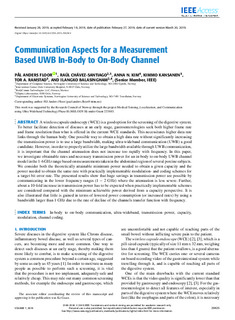| dc.contributor.author | Floor, Pål Anders | |
| dc.contributor.author | Chavez-Santiago, Raul | |
| dc.contributor.author | Kim, Anna N. | |
| dc.contributor.author | Kansanen, Kimmo | |
| dc.contributor.author | Ramstad, Tor Audun | |
| dc.contributor.author | Balasingham, Ilangko | |
| dc.date.accessioned | 2019-07-12T11:37:56Z | |
| dc.date.available | 2019-07-12T11:37:56Z | |
| dc.date.created | 2019-07-09T23:44:36Z | |
| dc.date.issued | 2019 | |
| dc.identifier.citation | IEEE Access. 2019, 7 29425-29440. | nb_NO |
| dc.identifier.issn | 2169-3536 | |
| dc.identifier.uri | http://hdl.handle.net/11250/2605149 | |
| dc.description.abstract | A wireless capsule endoscopy (WCE) is a good option for the screening of the digestive system. To better facilitate detection of diseases at an early stage, gastroenterologists seek both higher frame rate and frame resolution than what is offered in the current WCE standards. This necessitates higher data rate links through the human body. One possible way to obtain a high data rate without significantly increasing the transmission power is to use a large bandwidth, making ultra-wideband communication (UWB) a good candidate. However, in order to properly utilize the large bandwidth available through UWB communication, it is important that the channel attenuation does not increase too rapidly with frequency. In this paper, we investigate obtainable rates and necessary transmission power for an in-body to on-body UWB channel model in the 1-6 GHz range based on measurements taken in the abdominal region of several porcine subjects. We consider both the theoretically attainable minimum power needed to obtain a given capacity and the power needed to obtain the same rate with practically implementable modulation- and coding schemes for a target bit error rate. The presented results show that huge savings in transmission power are possible by communicating in the lower frequency ranges (1 - 2 GHz) where the attenuation is less severe. Further, about a 10-fold increase in transmission power has to be expected when practically implementable schemes are considered compared with the minimum achievable power derived from a capacity perspective. It is also illustrated that little is gained in terms of lowered power consumption (or increased rates) by using a bandwidth larger than 1 GHz due to the rate of decline of the channels transfer function with frequency. | nb_NO |
| dc.language.iso | eng | nb_NO |
| dc.publisher | Institute of Electrical and Electronics Engineers (IEEE) | nb_NO |
| dc.title | Communication Aspects for a Measurement Based UWB in-Body to on-Body Channel | nb_NO |
| dc.type | Journal article | nb_NO |
| dc.type | Peer reviewed | nb_NO |
| dc.description.version | publishedVersion | nb_NO |
| dc.source.pagenumber | 29425-29440 | nb_NO |
| dc.source.volume | 7 | nb_NO |
| dc.source.journal | IEEE Access | nb_NO |
| dc.identifier.doi | 10.1109/ACCESS.2019.2902104 | |
| dc.identifier.cristin | 1710935 | |
| dc.description.localcode | Copyright 2019 IEEE. Translations and content mining are permitted for academic research only. Personal use is also permitted, but republication/redistribution requires IEEE permission. | nb_NO |
| cristin.unitcode | 194,63,10,0 | |
| cristin.unitcode | 194,63,35,0 | |
| cristin.unitname | Institutt for datateknologi og informatikk | |
| cristin.unitname | Institutt for elektroniske systemer | |
| cristin.ispublished | true | |
| cristin.fulltext | original | |
| cristin.qualitycode | 1 | |
